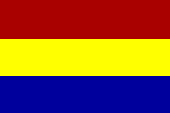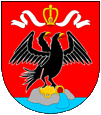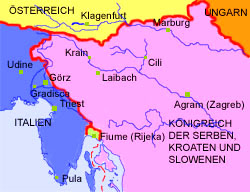mobile View, to the German Version tap the flag


- City of Fiume
- 1920–1924 Free State of Fiume
- situated in the east of the Istria Peninsula at the coast of the Adria
- own names: German: St. Veit (St. Vitus), Hungarian: Szentvit, Italian: Fiume, Croatian: Rijeka
• Flag
• Meaning/Origin of the Flag
• Coat of Arms
• Meaning/Origin of the Coat of Arms
• Map
• Numbers and Facts
• History
• Origin of the Country's Name

1920–1924,
National and merchant flag of the Free State of Fiume,
Source, by:
Wikipedia (D)




The flag od the Free State of Fiume shows three horizontal stripes in crimson, gold and blue. The colours have their roots ostensibly in the coat of arms.
Source: Volker Preuß


Coat of arms of Fiume,
Source:
Wikipedia (D)

The coat of arms of Fiume showed a red shield. On it a black twin-eagle (device of the Habsburg's monarchy) sitting on a riff. It points with both heads to the left (east) an holds a amphora in its claws and out of it runs water. This is a hint at the motto of the town: "INDEFICIENTER" = "never empty". Above that a crown.
Source:
Volker Preuß


Source:
Volker Preuß

Area: 11 square miles (1922)
Inhabitants: 52 000 (1922), 128 600 (2011), thereof nowadays: 80% Croats, 6% Serbs, 2% Italians
Languages (1910): Italian, Croatian, Hungarian, German
Languages (nowadays): Croatian, Italian
Currency (to 18th of Apr. 1919): 1 Krone (Corona) = 100 Heller
Currency (19th of Apr. 1919 to Sept. 1920): 1 Fiume Crown (Cor., FIUK) = 100 Centesimi = 40 Italian Centesimi
Currency (Sept. 1920 to 1945): 1 Italian Lira = 100 Centesimi
Time Zone: GMT + 1 h
Source: Wikipedia (D),
Der Michel (Europa)

ca. 400 B.C. · establishment of a Celtic smallholding named "Tarsa" with a some distant harbor, later conquest by Illyrian Liburners and Iapodes, extension to a piracy base which is named "Liburnia" by the Romans
ca. 180 B.C. · conquest and ruin of Liburnia by the Romans, rebuilding near the old harbor as "Tarsatica"
395 · at the partition of the Roman Empire Tarsatica comes to the West Roman Empire (Rome)
489–553 · the town belongs to the Empire of the Eastern Goth
553 · the town belongs to the East Roman Empire (Byzantium)
7th cent. · settlement of the Tarsatica region by Slavs (Croats), the name of the town changes in the course of times to "Trsat" or "Trsata"
800 · conquest and ruin by the Frankish Empire of the Carolingians
924 · Trsat comes to the Kingdom of Croatia
1102 · Croatia comes to the Kingdom of Hungary
13th cent. · foundation of the towns "Rika" and "St. Veit" at the other side of the Flaum River, in the course of times they grow together to the Town of Rijeka, growing Venetian/Italian influence and settlement, the Italian name of the town "Fiume" achieves instead of Rijeka, Trsat at the other bank of Flaum River grows together in the course of times in Fiume
1466 · the House of Habsburg purchases Fiume from Hungary, affiliation to the Duchy of Krain
1779 · Fiume comes under the Hungarian crown again
1797–1809 · French Revolutionar Wars, Fiume becomes occupied by the Frenchmen
1809 · Peace of Vienna, Austria cedes whole Istria, Triest, Krain and Carinthia to France, Hungargy cedes parts of Dalmatia (including Fiume) to France
1810 · the former Hungarian Dalmatia, Triest, Istria, Krain, Croatia, Carinthia and the former Austrian Dalmatia become summarized to the French "Illyrian Provinces"
1813 · Fiume becomes conquered back by Austria
29th of March 1815 · Vienna Congress, Austria (House of Habsburg) acquires back the in 1809 lost territories, Fiume comes to Hungary again
1867 · Austrian-Hungarian conciliation, creation of the State of Austria-Hungary, Fiume becomes a Free Town (quasi Cown Land) within Hungary
1914–1918 · First World War, thereafter breakdown of the imperial-royal monarchy, disintegration of Austria-Hungary in national states, Fiume becomes a objekt of quarrel between Croatia and Italy (the majority of the inhabitants were Italians)
10th of September 1919 · Treaty of Peace of Saint-Germain after the First World War, Austria has to cede its territories southern the Alps Mountains, Fiume comes to Croatia respectively the Kingdom of the Serbs, Croats and Slovenes (Yugoslavia)
12th of September 1919 · Fiume becomes occupied by Italian volunteers under the leadership of the fascist author Gabriele d'Annunzio, proclamation of the "Reggenza Italiana del Carnaro" => Italian Regency at the Quarner
12th of November 1920 · Treaty for the formation of the Free State of Fiume between Italy and the Kingdom of the Serbs, Croats and Slovenes (v), d'Annunzio declares because of that the war to Italy
January 1921 · debarkation of the Italian fleet, d'Annunzio leaves the town
March 1922 · agitations and pro-Italian military coup d’état
27th of January 1924 · the Free State of Fiume becomes splited between Italy and the Kingdom of the Serbs, Croats and Slovenes (Yugoslavia). The Town of Fiume comes to Italy, the suburb Susak and the hinterland to Croatia (Kingdom of the Serbs, Croats and Slovenes)
1939–1945 · Second World War
13th of October 1943 · capitulation of Italy, as a result of that occupys Germany among other Fiume
May 1945 · Fiume becomes occupied by Yugoslav partisans and incorporated as "Rijeka" to Croatia (Yugoslavia)
1947 · the Italian-Yugoslav Treaty of Triest confirms the affiliation of Fiume (Rijeka) to Croatia (Yugoslavia)
Source: Atlas zur Geschichte,
Wikipedia (D)

The town owned und owns many various names (Fiume, Rijeka, Reka, Rieka, Sankt Veit am Flaum, Szentvit), which are all from different origin. The today's town is first of all to imagine as a by diverse suburbs assembled city, which were not only founded in different times, but were as well inhabited in different times or were the urban center. The town is positioned at a northern and at the mouth of a river. A first Celtic smallholding arised ca. 400 B.C. It was situated eastern the river's mouth some distant from the coast and was named „Tarsa“. That means „Mountain at the Sea“ (on this mountain was later build the today's landmark of the town, the Castle of „Trsat“). Later was build a harbor. Tarsa was then conquered by Illyrian Liburns and Iapods and used and build up as a piracy base. The Roman Empire named the town „Liburnia“ in accordance with the name of the tribe of the Liburns. Ca. 180 B.C. Tarsa/Liburnia was conquered and ruined by the Romans. A new town was build between the harbor and the old and destroyed Tarsa. It was named „Tarsatica“. The river was simply named „Flumen“ what means "river". The in the 7th century A.D. immigrated Slavs changed in the course of times the Roman name of the town in "Trsat" or "Trsata". The name of the river was translated too. In this way became out of the Roman "Flumen" a Slavic „Rika“ or even a small river „Rijecina“. The immigrated Italians (Venetians) translated the Latin name of the river too and named it „Fiume“. In the 13th century were found western the river's mouth the places "Rika" and "St. Veit". The name „Rika“ refers to the name of the river and St. Veit was probably found by Italians. In this time the area belonged to Hungary and in this way the name „St. Veit“ was altered in Hungarian language in „Szentvit“. Latest by the affiliation to the Holy Roman Empire of German Nation were also in use German geographical names for the town and the river. The Germans called the river „Flaum“. As German name for the whole town achieved "St. Veit" because that was obviously the most important of the three towns in the times of the awarding of the name. "Rika" and "St. Veit" growed together to one town in the course of times, which the Slavs called "Rika" or later "Rijeka". The here living Italians took over that practice and called the town as well like the river, but in Italian: „Fiume“. The place Trsat (at the other side of the river) growed together with Fiume/Rijeka in the course of times.
Source:
Wikipedia (D)


![]()






